|

< Back to Career archive
1971-1975: The era of the rock festival
The next turning point in my career was 1971. After having no holiday for two years (who wants to go on holiday when you can have so much fun at work?), I took leave from GTV to attend The Odyssey Rock Festival at Wallacia near Sydney in early 1971. This festival was next to what had been used as Bullen’s Circus animal farm, and the word around the site was that the tripping hippie who encountered a stray llama was incoherent with surprise! I arrived a week early and set up a camp covered with branches under a tree, and watched the festival being put together. It was generally well-organised, although the festival started on Friday night and, as I remember, the first toilets were finished on Sunday. The queues (and the smell in the blow-up vinyl toilet enclosures cooking in the summer sun) had to be experienced to be believed. The Lenard PA system was typical of the day (scores of column speakers). A huge generator rattled away right behind the stage. There were food stalls and all sorts of hippie paraphernalia on sale (I purchased my first roach-clip at this festival – if younger readers don’t know what one of these is, ask your parents). The line-up of bands was fantastic (I saw Daddy Cool for the first time at this festival and Wendy Saddington and Copperwine played an inspired blues set). I took particular note of the stage lighting (by Rainbow Lights out of Sydney). John McKissock of what would become Clearlight Shows was working on this festival and stated that the “non-cash” method of payment tended to restrict the budget. I took careful note of all I saw and recorded a total of twenty minutes of the festival on super-eight film. Edited into a package later, this would become a valuable template for the future.
On my return to work I was extolling the virtues of the Wallacia festival to my boss, the head of the GTV Lighting Department, John Fowler. He was slightly amused at my enthusiasm, and wondered out loud what would lead anyone to take on such a project. My reply was something like “15,000 kids times $5”. His eyes lit up and, in that moment, the famous Sunbury Rock Festival was conceived. Its gestation from that point was slow but very sure. John gathered some partners and advisors, and operated a dance called “Odessa” at Frankston to gain experience. The ESP Lightshow, of course, featured at “Odessa” along with Billy Thorpe and the Aztecs and Lobby Lloyd and the Wild Cherries. John looked carefully at my Wallacia film, and found the Duncan’s farm at Sunbury to hold the festival. I went out to the site with him, and we settled on a site for the stage. In September 1971, I resigned from GTV and went out on the road with the ESP Lightshow and began to build more lighting equipment to get ready for the first Sunbury festival in January 1972.
One of my regular gigs during this period was a lighting rig at an ice-rink on the corner of Warrigal Road and South Road run by “Ross the Wrecker” who owned the car yard next door. The stage jutted out from one wall of the old warehouse above the ice-rink and the whole building received a makeover from a couple of former GTV set painters who did the whole job in a couple of days with a little chemical help. The opening of the rink was delayed when the ice-making machine was mysteriously sabotaged (suspicions being that a competing ice rink was involved) but, once operations got underway, the new ice rink became quite popular as the opportunity to skate whilst a major band performed just above your head was quite a novelty. This and several other lighting gigs enabled me to buy a new mini-moke – the first (and only) car I have purchased by walking off the street into a dealership with the cash in my pocket...
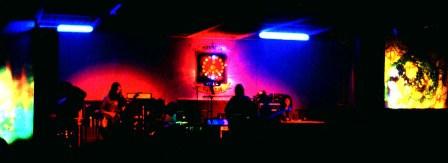
Lobby Loyde and the Wild Cherries with the ESP Lightshow at “Odessa”
There are already plenty of sites dedicated to the Sunbury festivals, so there is no need to elaborate much here, save to say something about my personal experiences and to state my opinion that the management of the festival was of a standard unequalled in Australia to that date. All the facilities were completed on time. Water and power were laid on where and when required. The who’s who of Australian bands played almost continually for three and a half days. The whole event was a tribute to the professionalism of John Fowler and his partners who, at Sunbury 1972, set the standard that all future rock festivals would be expected to meet.
The ESP Lightshow crew arrived on site about a week out from the festival and settled into a campsite on the river bank. There was a lot to be done – trenches to be dug for cables, confirm the follow spot tower locations with the scaffolders, and build a tower behind the stage for all the effects lighting. (The work was, of course, interspersed with swims in the river and other recreational activities). All of the equipment was transported out to the site behind my white mini-moke in the ESP trailer – a large number of trips had to be made from the Strand Lighting warehouse in Burwood, as well as bringing out the ESP equipment. This included the giant white cotton screen laced behind the stage. This screen was sown by my mother with help from all the family. The sewing machine was set up in the middle of the house and the material was walked from the back of the house and out the front door as each run of material was added to the screen, with my sisters shaking their heads at the crazy ideas their older brother had. To put it up at Sunbury we had to wait for a windless day. The screen was laced straight to the scaffolding and then horizontal and vertical ropes stretched across behind the screen and pulled taut to make sure it would not billow in the wind and tear. It’s a tribute to my mother’s sewing skills that the screen not only survived but made a second trip to Sunbury the following year. It is here that I should mention the lighting crew who worked on the festival with me – Ross Macpherson, Kevin McGrath, Mario Petri, Brett Randall, Bob Smiley and David Winslade.
Finally the generator turned up – mounted on a trailer, very industrial looking, no sound-proofing and smelling of spilt diesel. It was connected up to the lighting console and at last we were able to focus some lights. The following day the punters began to flood into the site and, on the Friday afternoon the PA cranked into life as the opening bands did their sets. As dusk fell and I prepared for my part in the festival, the lighting crew were assembled in the lighting control enclosure at the front of the stage to share a smoke or two prior to the show. At this point the compere (either Adrian Rawlins or Gerry Humphries, I don’t remember which) looked down from the front of the stage and said ”Oh look, they’re smoking drugs in the lighting pit”.
Unfortunately, he was standing right next to a microphone at the time, and the pronouncement boomed out over the festival site. Since none of us were aware how the police might react to such a statement, the fellow spot operators bolted and it was some time before I could get them back together again ... The Cambridge Films feature of Sunbury ’72 is widely available on DVD (see https://www.umbrellaent.com.au/music/8-sunbury72---sunbury-rock-festival.html) so, if you want to see how the festival went, pictures are readily available. The 23-year-old me is pretty obvious bopping up and down at the lighting console in front of the stage wearing my trademark bowler hat. I don’t remember how much I charged for lighting the festival or how much profit I made after paying my crew, but it must have been enough to tempt me to return for 1973 and 1974.
With Sunbury ‘72 over, I did a number of jobs with Billy Thorpe and the Aztecs in country towns in partnership with Peter Matthews of Brown Eye Lights. Probably Hamilton was the most notable, especially for the aftermath where an enthusiastic young local copper insisted in helping two somewhat substance-affected young lighting trogs in loading-out of the theatre and getting the gear back into the ESP trailer. The mixture of paranoia and giggling on the part of the two trogs must just have been passed off as some sort of “big city” weirdness. The following week Peter and I tried our hands as promoters running a dance at the Burwood RSL and lost the entire proceeds of the country tour when only five people turned up. The band members outnumbered the punters! Only the fact that the headline band turned up late into the night, looked in the door, and expressed their willingness to take the rest of the night off saved us from further loss. That cured me of any desire to become a promoter.
In 1972 I also had the opportunity to light a free 3XY concert at the Myer Music Bowl compered by Gerry Humphries at which Billy Thorpe and the Aztecs, Company Caine, La Di Das and Friends headlined. The set-up time for this show was extremely limited. “Music for the People” with Hector Crawford as conductor preceded this show in the afternoon and, even before the concert had finished, thousands of long-haired young people were spilling over the top of the hill. The only way out for the blue-rinse set with their tartan rugs and cane picnic baskets was via the side of stage. Unfortunately, Hector decided they had all come up to congratulate him and stood at the side of the stage and shook everyone’s’ hand whilst the Jands crew, ESP crew and band roadies were trying to load-in sound, lights and backline through the same doorway. The show started on time with an audience that has been estimated to have rivalled that for “The Seekers” at the same venue some years earlier of a quarter of a million people. I would certainly believe that from the view at my lighting position at the side of the stage. The concert took off like an explosion in a fireworks factory. The energy of the crowd was fantastic, but, afterwards, all of the backs of the fixed bench seating (which was hardened spring steel) had been bent flat from people standing on the backs of the seats to get a better view. I saw several people crushed against the railings at the front of the stage (and have the photographs to prove it), with the security guys trying to haul them clear and into the orchestra pit. It was absolute mayhem and it was a wonder that more people were not hurt. It is a good thing that the training of security staff and crowd control procedures has improved these days. As it was, I believe we were not short of a major disaster back in 1972.
I returned for Sunbury 1973 while on leave from the Audio Department at GTV. The lighting rig had again expanded, and my favourite “look” was the one we developed for leading-edge experimental band “McKenzie Theory”. I lit the whole stage in purple while their manager crawled on the access planks in the roof of the stage and sprinkled silver glitter slowly over the band. This was complemented by contrasty black and white abstract images projected onto the screen behind the band – an eclectic mix of close-ups of foliage, old rope and dead cats etc. (The images were produced by the then boyfriend of one of my sisters, and I still have all this material stored away at home somewhere). Unfortunately, 1973 is also memorable as the year we lost the follow spot towers. It had always been difficult to persuade the punters to keep off the follow spot towers, but the Saturday night of the ’73 Festival was a nightmare. The towers were definitely unsafe with that many people on the lower levels and the follow spot operators were getting quite scared as the towers were moving much more than they should. I had a word to Molly Meldrum and, over the PA, he asked the punters to get down, but was completely ignored. The show could not go on until the towers were cleared, so Molly asked the crowd to throw cans at the punters to get them to climb down. This had the desired result, but Molly forgot to tell the crowd that the people on the upper level were actually working on the show. The follow spot operators were forced from the towers for their own protection and then, despite the still-flying cans, a couple of drunken idiots climbed onto the top level and threw some of the follow spots over the side. This had the potential to kill someone, but I had chained both spots and stands to the towers so, instead of crashing to the ground, they merely swung rather precariously over the audiences’ heads. Something had to be done, so Mario Petri and I approached the Bob Jones’ security guys to come out with us to help bring the spots down. They point blank refused, so Mario and I trudged through the crowd to the towers, climbed up, rescued the spots and lowered them to the ground with ropes. We then had to carefully pick our way back to the stage with a Strand Pattern 293 follow spot over one shoulder and the stand in our other hand, and then repeat the trip all over again for the second two spots. Those older lighting guys out there will realise that this was quite a feat, and if any of the many drunks in the crowd had tried to “king-hit” us (and everyone was a bit pissed off at the delay in proceedings) we would have been completely defenceless. I don’t think I have ever been more scared in my life. The scaffolders tore down the remains of the towers during the night and the stumps of the towers feature in subsequent photographs of the festival.

The aftermath – the stumps of the towers in the crowd on Sunday morning
Sunday morning was occupied with building temporary platforms for two of the spots over the PA wings on the stage. The third was used at ground level for the feature act on Sunday night – Johnny O’Keefe. I received strict instructions from his manager before the set that no colour was to be used, no lights were to be flashed, and no effects used on the screen behind the band. So the lighting was pretty boring but JOK absolutely wowed the audience.
He looked so nervous when he first came on that I initially thought his choice of a white suit might have been a big mistake - but he quickly overcame his nervousness and, two songs in, was really cooking.
In 1974 I again took leave to light Sunbury. By now I was convinced that rear-projection had become a bit passé, and I wanted to pour all my energies into an expanded stage lighting rig. John Fowler was a bit concerned about this, and engaged John McKissock of Clearlight to look after the projection screen and lighting effects. Unfortunately for John McKissock, most of the bands no longer wanted the effects lighting and he had little to do, but was still faced with the job of clearing three days of Sunbury dust out of his projectors afterwards.
I made sure the debacle of the follow spot towers was not going to be repeated and we built a single central tower to take four follow spots, the lighting console, and a large mirror ball to take some of the lighting effects out into the audience. The base of the tower was well walled-in with Cyclone wire with a locked gate in the bottom. Any persistent would-be trespassers could be warned off by the threat of the contents of the empty orange juice bottles we had collected. I’m sure you can imagine what five blokes trapped on a tower for ten hours had filled them with. Sunbury ’74 was also the year that English band ‘Queen” played Sunbury. I was introduced to the band during the day and told I could pretty much look after the lighting as I wanted. Unfortunately for “Queen”, they were scheduled to play just before The Aztecs, and had to endure the chant of “We want Thorpie” all the way through their set. No wonder they never came back to Australia. Billy Thorpe and the Aztecs were, of course, the highlight of the festival once again. By this time Billy had acquired his own lighting technician (from the Australian Ballet), but I was again allowed to “do my own thing” apart from a surprise number where the brightly-coloured converted Strand 252 effects wheels Mario and I had created were specifically called for. This was of course, the first “Sunbury” Aztec performance of the hit of a much younger Billy Thorpe, “Somewhere, Over the Rainbow”.
I was again approached to light Sunbury 1975 but had just purchased a house, had a young child, and was by now far more interested in audio, so I declined. For the first time on a Sunbury weekend, it poured. I attended the festival on Saturday night as a guest of John Fowler and stood in a sparse crowd in ankle-deep mud to watch the performance of headline act “Deep Purple”. Unfortunately for John Fowler and Odessa Promotions, they were one millimetre short of the rainfall they required to claim on their rain insurance. Deep Purple had insisted on being paid before they left the UK, and there was little left to pay for local technicians and bands. It was an ignominious end for a fine festival which had set new standards of competent management.
Next page >
|
 |
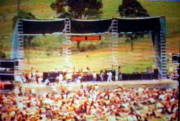
The stage at the Odyssey Rock Festival at Wallacia
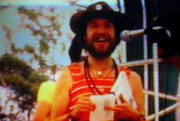
Odyssey Promoter and compere Adrian Rawlins
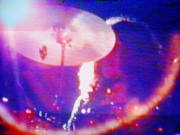
A night shot at the Odyssey Festival taken from my 8mm film of the event
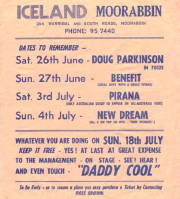
1972 Poster for “Iceland”
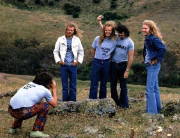
Publicity shoot with Billy Thorpe and the Aztecs prior to the first Sunbury Festival
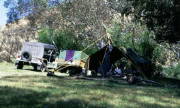
The ESP Mini-Moke, trailer and campsite at Sunbury ‘72
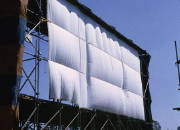
The rear-projection screen
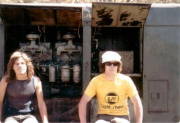
Ross Macpherson, Kevin McGrath and the LX generator

Compere Gerry Humphries
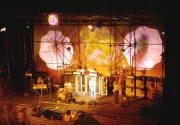
The Aztecs at Sunbury ’72, with bowler-hatted Peter Evans at the lighting console
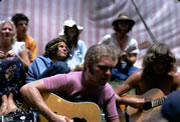
Billy Thorpe in an impromptu jam on the riverbank at Sunbury ‘72
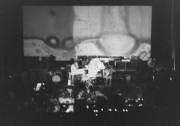
The Aztecs at Hamilton. The effect on the screen is bubbles blown through hollow glass 35mm slides filled with coloured liquids
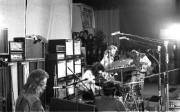
The Aztecs at the 3XY concert at the Myer Music Bowl
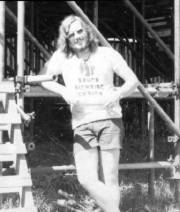
A happy hippy – Peter Evans in ESP lightshow T-shirt leaning against the stage at Sunbury ‘73
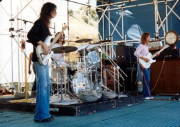
Band at Sunbury ‘73
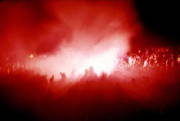
Flare in crowd, Sunbury ‘73
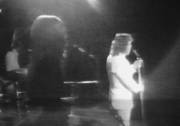
Johnny O’Keefe performing at Sunbury ‘73
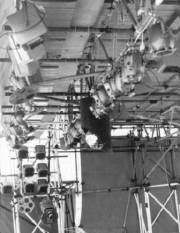
The ESP lighting rig at Sunbury ’74, with Strand Electric products very much in evidence.
|
